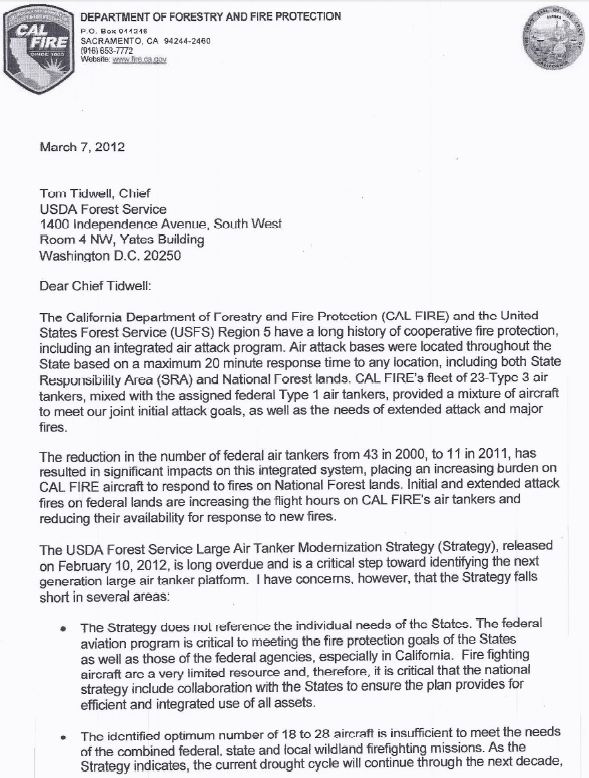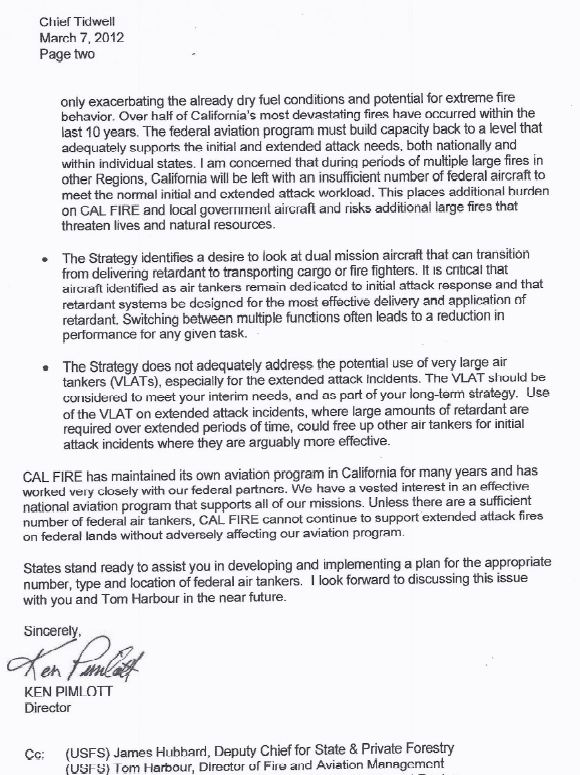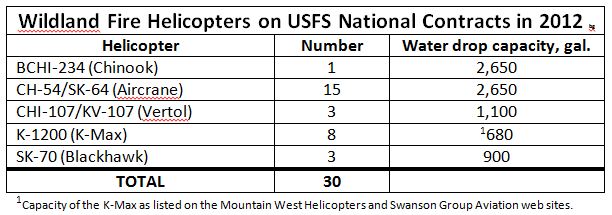The letter below that Ken Pimlott, the Director of the California Department of Forestry and Fire Protection wrote to the Chief of the U.S. Forest Service, Tom Tidwell, states unequivocally that CAL FIRE is not pleased with the current state of the large air tanker fleet which has disintegrated by 75 percent over the last 10 years to only the 11 we have today. They also point out that the recent USFS Large Air Tanker Modernization Strategy is insufficient to meet the needs of the combined federal, state and local wildland firefighting missions.
Tag: air tanker
North Carolina’s CL-215 being sold by company featured on reality show
You may remember when Wildfire Today told you last year that the state of North Carolina sold their CL-215 water-scooping air tanker on eBay for $445,099. Money was cited as the reason for unloading the aircraft, and at the time the state government was not overflowing with cash. David Lane, head of the forest protection for the state’s Division of Forest Resources, said it cost up to $1.2 million a year to operate, which was 35 percent of the division’s aircraft budget and they did not have the funding for an estimated $1.5 million needed for repairs and FAA-required maintenance.

There are several twists to this story.
The aircraft is now listed for sale by the new buyer for $3.5 million, almost eight times North Carolina’s selling price, but it remains to be seen if anyone will pay that price. The state bought the aircraft, which was manufactured in 1969, for $4 million in 1998.
North Carolina sold the air tanker a month before the 20,000+ acre Pains Bay fire started. Fire managers in the state loved the aircraft, and for 14 years had counted on the quick turn-around 1,400-gallon water drops it could make. It was replaced with some contracted single-engine air tankers that could also scoop water.
The company that bought the CL-215 on eBay, Buffalo Airways of Yellowknife, Northwest Territory, Canada has their own reality show on the National Geographic and History Channels called “Ice Pilots”. Buffalo has owned other CL-215s. We wrote about the show in August of last year when they aired a series of episodes in which the company had sold two of them to the Turkish government and were attempting to deliver them to the buyer, flying them across Canada, the north Atlantic, and Europe. (I never heard if they made it all the way to Turkey.) The Weather Channel has picked up “Ice Pilots” and is showing season three at 9 p.m. ET on Mondays. A fourth season is currently in production. You can watch full episodes of the show online at History Television (update, but it appears that only Canadians can view the online episodes).
The Charlotte Observer has more details about the saga of North Carolina’s CL-215.
SEAT at Hot Springs, SD

With South Dakota and other Northern Great Plains States suddenly coming into wildfire season a single engine air tanker has been positioned at the airport at Hot Springs, South Dakota. An air attack platform, a King Air, is also on standby at Rapid City and a Blackhawk helicopter is available from the National Guard base at the Rapid City airport.
We spent a few minutes at the Hot Springs air attack base today and talked with Base Manager Winston Cadotte and pilot Jim Fournier. Tanker 466 is under contract from New Frontier Aviation and is operated by Taylor Aviation.
UPDATE: earlier we identified the aircraft as an Air Tractor 802, but Scott in a comment said it is a Dromader, and we now believe he is right. It appears to be a M-18T Dromader. Sorry for the confusion.

USFS reduces the number of helicopters on national contracts
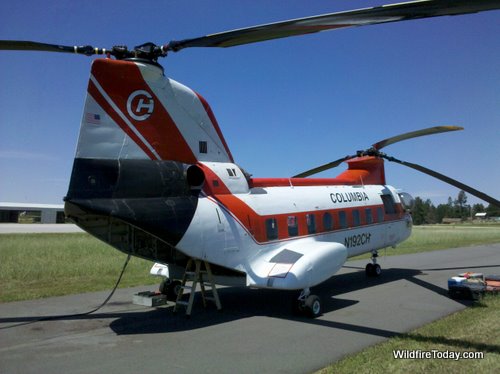
When we reported on some of the statements that the Chief of the U.S. Forest Service made on Tuesday when he testified before a congressional committee, some of the information about the availability of helicopters raised my curiosity. Chief Tom Tidwell said there will be 30 large Type 1 helicopters on national contracts this year compared to 34 last year, but not all of those last year were Type 1, so this year, according to Chief Tidwell, there will be a net increase in the number of gallons of water that can be carried.
We confirmed that yes, there will be 30 helicopters on national U.S. Forest Service contracts in 2012. The Request for Proposal that the agency issued was for 34 helicopters, but the USFS decided to eliminate four — at Alturas, CA; Oakridge, OR; Orland, CA; and Porterville, CA.
It is debatable whether all 30 of them are Type 1 helicopters, as Chief Tidwell stated. Eight of the 30 are K-1200 (K-Max) ships that have a capacity of 680 gallons of water in an external load, according to the capabilities listed on two of the K-Max contractors’ web sites. The standard for a Type 1 helicopter is for it to be able to carry at least 700 gallons. If someone is listing the K-Max as a Type 1, it is very close to the minimum number of gallons, while as you can see in the chart below, the other helicopters on contract this year can carry from 900 to 2,650 gallons.
The K-Max has by far the cheapest hourly rate of all of the helicopters on contract this year– about 1/6 of the largest Type 1s. And it has by far the smallest capacity. However, the USFS Chief feels free to say all of the helicopters on national contract are Type 1.
One change that was noted in the new contract is that the Boeing Vertol 107 that was at Custer, South Dakota, is being replaced with a smaller K-Max, reducing the number of gallons carried by 38 percent. A cynic might think that in this case the USFS is strictly saving money, with little regard to firefighting capability.
The National Interagency Aviation Council study that was approved by the National Wildfire Coordinating Group in July, 2008, recommended that there be on contract in 2012, 34 Type 1 helicopters, 47 Type 2 helicopters, and 100 Type 3 helicopters. The same study recommended that there be by this year 23 large air tankers plus 3 water scooper air tankers on contract, for a total of 26, and by 2018 a total of 35 (32 plus 3).
Since the number of large air tankers on USFS national exclusive use contracts has decreased by 75% since 2002, down to 11 today, it is difficult to understand the logic of decreasing the number of helicopters. A rational person would attempt to fill the void with more, rather than less. A rational person would also be alarmed that the unable to fill rate for air tanker orders in 2011, a slow fire season in most of the country, was 30 percent.
This state of the wildfire aviation program can be attributed to management that is characterized as lethargic, apathetic, indifferent, timid, passive, indecisive, and afflicted with the Peter Principle and analysis paralysis, as evidenced by the five wildfire aviation studies over the last 16 years that are sitting on shelves, largely ignored. This sorry state of the program has existed for the last 10 years. The citizens deserve better from the stewards of the land.
Forest Service Chief testifies about wildfire budget and air tankers
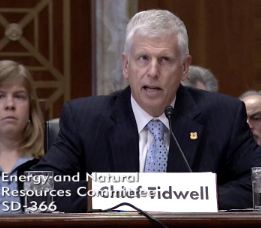
The Chief of the U.S. Forest Service told a congressional committee on Tuesday that he expects the wildfire suppression budget to be “tight” this year and that he plans to rely more on the military’s eight MAFFS air tankers than the agency did last year.
In front of the Senate Committee on Energy and Natural Resources, Chief Tom Tidwell read a prepared statement about the FY 2013 USFS budget and then answered questions from members of the committee.
While the proposed budget fully funds the 10-year average cost of wildland fire suppression operations for FY 2013, Chief Tidwell said that based on current and predicted conditions, this year “it’s going to be tight for us to have adequate funding for fire suppression”.
Two senators, Ron Wyden of Oregon and Lisa Murkowsk of Alaska, gave their opinions and asked detailed questions about the availability of air tankers. Senator Wyden said that the USFS should speed up the adoption of new technology, and gave an example of a very large air tanker in his state that has seven times the capacity of standard large air tankers. He was obviously referring to Evergreen’s 747, Tanker 979, which holds 20,000 gallons. The USFS has not been interested in offering exclusive use contracts for any very large air tankers (VLAT) and has only made call when needed contracts available. Evergreen has said they cannot continue to make the 747 available on a CWN basis with a very uncertain income stream. Another VLAT vendor, 10 Tanker Air Carrier, did accept the CWN contract and is struggling to manage their two DC-10s with no guarantee of income.
Senator Wyden told Chief Tidwell that he wants Mr. Tidwell within 30 days to respond to him and a bipartisan group of Senators explaining what the USFS will do to consider “new technology” and the use of VLATs.
Chief Tidwell said this year the agency will contract for two scooper air tankers (presumably CL-215s or CL-415’s) for the first time. He said the recent request for proposals for “next generation” air tankers will produce three additional air tankers this year and four more in 2013. Adding the two scoopers and three next-gen air tankers would bring the total from 11 last year to 16 this year. This compares to the 19 at the beginning of 2011, the 11 at the end of 2011, and the 44 in 2002. Chief Tidwell said that under the air tanker strategy announced recently by the USFS, he expects there will be 18 to 28 large air tankers eventually under contract.
He said there will be 30 large Type 1 helicopters on national contracts this year compared to 34 last year, but not all of those last year were Type 1, so this year there will be a net increase in the number of gallons that can be carried.
Chief Tidwell also testified that he expects to rely more this year than last year on the Mobile Airborne Fire Fighting Systems (MAFFS) C-130 air tankers operated by the Air National Guard and the Air Force reserve. But Senator Murkowski confronted him with the fact that “the military does not desire to take on additional responsibilities with the C-130s”. She said “We need to be very cognizant of the stresses we are putting on the [Air National Guard and Air Force Reserve] system.”
Chief Tidwell responded:
The Department of Defense is not interested in expanding their mission to assist in this, but also at the same time they are going to continue to work with us to provide these air national guard unit planes when we need them after everything else is fully committed. It is part of our strategy to help bridge. If we have an active fire season we are going to have to rely on those eight MAFFS planes.
A video of the 110-minute hearing can be found on the Energy and Natural Resources Committee’s web site.
MAFFS training in California
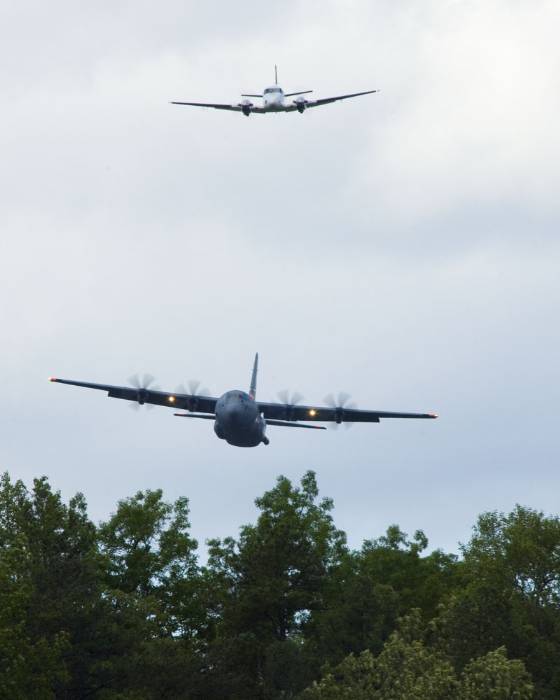
The two Modular Airborne Fire Fighting Systems (MAFFS) air tankers based at the Channel Islands Air National Guard in Port Hueneme, California are participating in training this week for wildfire assignments. The portable MAFFS units can be inserted into the cargo holds of military C-130J aircraft within a few hours to be used when the privately-owned air tankers that are under contract to the federal government are committed on fires or otherwise not available. The training began on Monday and will conclude on Thursday.
Three other bases in the United States have two aircraft each that are designated as MAFFS-deployable, stationed in Colorado, Wyoming, and South Carolina. Usually the aircraft from multiple bases assemble in one area for their annual training and recertification, but this year the California aircraft and crews will not be joined by MAFFS aircraft from other states. Last year the Colorado and Wyoming units met in Idaho for the training, and in 2010 all four bases sent their aircraft to South Carolina. Major Kimberly Holman told us that a cost reduction initiative was the reason for the localized training.
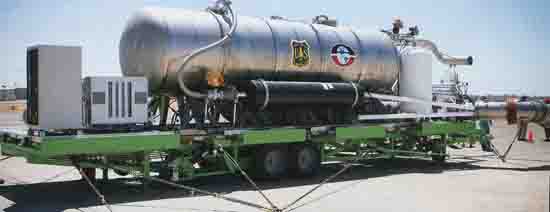
This year in California, more than 100 personnel from he 146th Airlift Wing and the U.S. Forest Service will come together to accomplish the weeklong training sponsored by the USFS and the Air National Guard. The certification event will include classroom sessions and flight training for military flight crews, civilian lead plane pilots, and various support personnel. Water drops will be executed in the nearby Angeles National Forest and in Kern County. Rural residents in those areas may see low-flying C-130 aircraft and Forest Service lead planes throughout the week.
The Times-News has some other photos of the aircraft and personnel.

